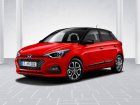Comparison Hyundai i20 II (GB facelift 2018) 1.2 (84 Hp)

Add car |

Remove car |
| Brand: | Hyundai |
| Model: | i20 |
| Generation: | i20 II (GB facelift 2018) |
| Engine / modification: | 1.2 (84 Hp) |
| Production start: | 2018 year |
| Production end: | 2020 year |
| Coupe type: | Hatchback |
| Num. of Doors: | 5 |
| Num. of seats: | 5 |
| Fuel consumption / economy - urban: | 7.1 l/100 km |
| Fuel consumption / economy - extra urban: | 5.0 l/100 km |
| Fuel consumption / economy - combined: | 5.8 l/100 km |
| Fuel Type: | Petrol (Gasoline) |
| Fuel tank volume: | 50 l |
| Emission standard: | Euro 6d |
| CO2 emissions: | 132 g/km |
| Power: | 84 hp |
| Max power in: | 6000 rpm. |
| Maximum speed: | 170 km/h |
| Acceleration from 0 to 100 km/h: | 12.8 sec |
| Torque: | 122 Nm @ 4000 rpm. |
| Engine position: | Front, transverse |
| Engine displacement: | 1248 cm3 |
| Fuel System: | Multi-point injection |
| Position of cylinders: | Inline |
| Valvetrain: | DOHC-CVVT |
| Number of cylinders: | 4 |
| Number of valves per cylinder: | 4 |
| Compression ratio: | 10.5 |
| Piston Stroke: | 78.8 mm |
| Cylinder Bore: | 71 mm |
| Wheel Drive: | Front wheel drive |
| Number of Gears (manual transmission): | 5 |
| Length: | 4035 mm |
| Width: | 1734 mm |
| Width including mirrors: | 1985 mm |
| Height: | 1474 mm |
| Wheelbase: | 2570 mm |
| Front track: | 1514-1520 mm |
| Rear (Back) track: | 1513-1519 mm |
| Ride height(clearance): | 140 mm |
| Front overhang: | 815 mm |
| Rear overhang: | 650 mm |
| Minimum volume of Luggage (trunk): | 326 l |
| Maximum amount of Luggage (trunk): | 1024 l |
| Front suspension: | Independent, Spring McPherson, with stabilizer |
| Rear suspension: | Independent, spring |
| Max weight: | 1580 kg |
| Front brakes: | Ventilated discs |
| Rear brakes: | Drum |
| Kerb Weight: | 1055-1233 kg |
| ABS: | yes |
| Steering type: | Steering rack and pinion |
| Power steering: | Electric Steering |
| Max. roof load: | 70 kg |
| Minimum turning circle (turning diameter): | 10.2 m |
| Permitted trailer load with brakes (12%): | 910 kg |
| Permitted trailer load without brakes: | 450 kg |
| Permitted towbar download: | 75 kg |
| Tire size: | 185/65 R15; 195/55 R16 |
| Wheel rims size: | 6.0J x 15; 6.0J x 16 |